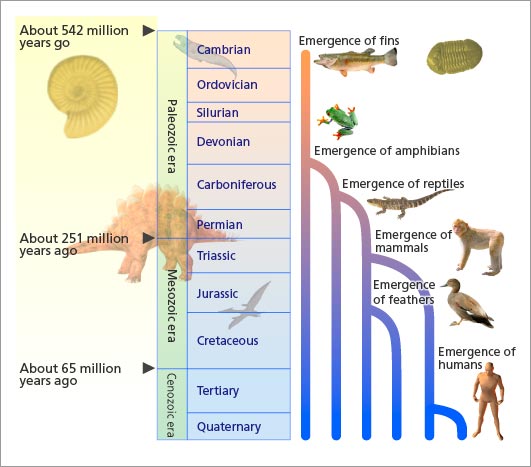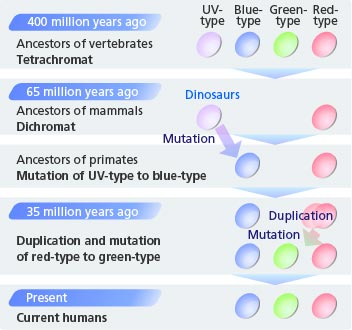Many people have experienced “love at first sight,” but why does the mere sight of a certain person provoke such a strong reaction? Man's distant ancestors once relied on smell and pheromones*1 to find suitable mates. Later, our ancestors developed the ability to see color, which led to a reduced sensitivity to odors and pheromones, and now most of the information necessary for finding a partner is visually perceived. Therefore, there must be a close relationship between the evolution of color vision and the criteria for selecting suitable mates.
- *1Volatile tasteless and odorless chemical substances that activate a behavioral response from the opposite sex of the same species. Besides sex-attractant pheromones, ants and honeybees have alarm pheromones.
A lover seen faintly
![]()

Figure 1: Replica of a painting of women found on the west wall of the Takamatsuzuka burial mound. These women are in the colorful costumes of the Asuka period (592 to 645), around the time the Manyoshu poems were composed.
Photo courtesy of the National Research Institute for Cultural Properties, Nara
Shown above is a love poem from an anthology of early classical Japanese poetry. This poem could be translated as: “I fell deeply in love with someone I had vaguely ‘seen,’ like a figure perceived through the morning mist.”
The poem comes from Japan's oldest collection of poetry, Manyoshu*2. It was sent by a woman named Kasa no Iratsume to her lover whom she met after yearning for him for a long time. In the period in which Manyoshu was penned, the word “see” conveyed a range of meanings, from simple viewing to physical love. In fact, the verb “to see” here represents all such meanings as meeting someone for the first time, conversing with someone, and making love.
How did such a simple word come to have such a complex range of meaning? The answer lies behind the history of human evolution.
- *2Japan's oldest collection of poems, it consists of 20 volumes containing more than 4,500 poems. Manyoshu is believed to have been composed and compiled sometime between the 7th and 8th century.
Chance triggered the evolution of color vision
Living things see the world differently. Birds and fish can recognize ultraviolet (UV) light, which is invisible to humans, while dogs can distinguish fewer colors than human beings can. Dogs compensate for their weakness of color vision with a sense of smell said to be 10,000 times more powerful than ours. Unlike humans, dogs inhabit a world ruled by scent.
The ability of each living thing to see color has evolved based on the vagaries of chance and environments. Two types of cells (or receptor cells) are responsible for the sense of vision: one type enables the recognition of color; the other type responds to varying degrees of light and dark. Of late, there have been great advances in the study of genes forming these cells, and researchers have discovered many new facts about genes, particularly those related to the recognition of different colors.
In the far distant past, the common ancestors of birds, reptiles and fish were tetrachromat. That is to say, they boasted genes that enabled them to see four color spectrums (UV, blue, green, and red types). All mammals are derived from the same ancestors. However, during the reign of the dinosaurs in the Mesozoic era, mammals lost the genes responsible for green and blue color recognition; consequently, mammals were dichromat, meaning they had the two-color vision system (UV and red types). It is conceivable that the reason that mammals survived, despite being hunted by dinosaurs, is that they became nocturnal. With this shift in behavior, the ability to discern four different colors would have been less important, and probably led to the arise of two-color vision.

Figure 2: The process of biological evolution down to humans
Living things cannot voluntarily evolve variants that, adapted to their environments, will allow for survival. When individual organisms with new functional capabilities happen to emerge, they thrive if they are adapted to their environments, otherwise they fail to bear offspring and disappear. According to Charles Darwin's Theory of Evolution, this process is known as natural selection.
How, then, can living things obtain new functional capabilities? There are two ways for genes to change: “mutation” and “duplication.” These changes are inextricably linked with the evolution of life.
New cells are continuously reproduced within living cells, replacing old ones. The genes within cells are replicated in the new cells when reproduced. The process of replication is not always perfect. Replication errors occur at a probability of one in 1,000 million. These occurrences are known as mutations. If a gene function important to survival is destroyed by mutation, the individual organism is not able to thrive or bear offspring.
Another form of error is termed “duplication,” which occurs when the copying of the same gene is unexpectedly made more than once. The duplicated genes may further mutate to add new functional capabilities. Only when newly obtained capabilities are adapted to the environments will the organisms thrive and spread; otherwise they will fail to bear offspring and disappear. The occasional repetition of duplication and mutation over many years has led to the evolution of organisms adapted to their environments.

Figure 3:
Evolutionary process of three-color vision in humans
The ancestors of vertebrates originally had genes that could distinguish four different colors, or the four-color vision system. Later, this color system regressed to two-color vision, then again evolved to three-color vision through duplication and mutation.
Let's go back to humans. With the extinction of the dinosaurs some 65 million years ago, the nocturnal ancestors of mammals returned to daylight activity. Some 30 million years later, the genes that these animals possessed for seeing red and blue duplicated and then mutated. This gave rise to the green-type gene capable of perceiving green light. Eventually, the three-color vision system (trichromat) developed. It is conceivable that mammals with the ability to see color gained dominance in the jungle because the ability to make fine distinctions in color is a significant advantage for daylight animals. It was then that our ancestors gained the ability to see color as we enjoy it today.
In the course of human evolution, once our ancestors had gained the ability to distinguish three colors they lost their keen sensitivity to smells and pheromones.
Evolution is devolution

Figure 4: Viewed through the eyes of a human with three-color vision (top) . The same scene viewed through the eyes of a catarrhine, a close primate relative, with two-color vision (bottom).
(The bottom is a digital image simulation of how it would look through two-color vision eyes.)
A few years ago, olfactory sense researcher Yoav Gilad and his colleagues at the Max Planck Research Institute in Germany noticed that our close primate relatives, catarrhines, which have three-color vision, have genes for smelling that devolved much more quickly than their cousins (such as New World monkeys), which have two-color vision (Fig. 5). What does this mean?
“Evolution is intimately tied with devolution,” so believes Prof. Naoyuki Takahata, vice president of the Graduate University for Advanced Studies. According to Prof. Takahata, although humans and mice share 99 percent of the same genes, there is a big difference in shape and functional capabilities between the two species. This is largely due to how much their genes have devolved.
The maximum number of genes responsible for color perception, for example, is only four, compared to 802 that control sense of smell in humans and 1391 in mice. However, humans use only 388, or less than half, of the total genes available. In other words, humans have evolved by devolving, or ceasing to use many of these genes through mutation.
The genes which are no longer functional due to mutation are called “pseudogenes.” Our close primate relatives (catarrhines) with three-color vision have larger portions of scent-related pseudogenes. Human olfactory pseudogenes account for more than 50% of our total scent genes, while those of apes and Old World monkeys account for 30% or more. On the contrary, two-color vision prosimian pseudogenes account for less than 20% of the total scent genes. It should be noted that the same pattern holds for the three-color vision howler monkey, which is not closely related to humans and still has more than 30% pseudogenes.
In other words, we can assume that the three-color vision system makes a keen olfactory sense less important.

Figure 5: Acquisition of three-color vision and percentage of olfactory pseudogenes.
This shows that our close primate relatives (catarrhines), which acquired the ability to see three colors, have a higher percentage of olfactory pseudogenes than those with two-color vision.
Vision and degeneration of sensitivity to pheromones
When humans and other primates (catarrhines) acquired the ability to see color and at the same time lost much of their sense of smell, they also lost the ability to detect pheromones. Pheromones are volatile tasteless and odorless chemical substances that influence behavioral response from a recipient of the same species. Geneticist Jianzhi Zhang and his colleagues at the University of Michigan found that once the ancestors of mammals developed three-color vision, genes sensitive to pheromones underwent a dramatic shift to become pseudogenes.
It is known that mice and rats have more than 100 pheromone sensitive genes. Humans, however, have only four, having lost most of them during the process of evolution. Even though these are not pseudogenes, our pheromone sensing ability is thought to have ceased functioning entirely.
Why did humans and our close relatives lose the ability to detect smells and pheromones? Researchers believe that this loss was attributable to the acquisition of three-color vision. For example, when Japanese monkeys and chimpanzee females come into season, their buttocks turn red. This phenomenon cannot be seen in New World monkeys, however, because they lack three-color vision. In other words, the ancestors of humans used smells and pheromones for recognizing suitable mates, but once they acquired the ability to see color, they became dependent on sight for such purpose. The decline in the role olfactory sense and pheromones played in recognizing suitable mates is thought to be one of the reasons for the rapid degeneration of sensitivity to smells and pheromones.
In the long history of life on Earth, all living things have been dependent on the ability to eat, mate, and leave offspring. Humans and other primates gained the ability to see color at the expense of losing a keen sense of smell and the ability to detect pheromones. Thus, for humans color vision has become the primary sense that we depend on for all aspects of our lives, from love to survival.
Editorial contributors / Date of article posted
Professor Yoko Satta and Fellow Yasuhiro Go of the Graduate University for Advanced Studies (Yasuhiro Go is also a postdoctoral academic at Harvard University.) / June 2006

